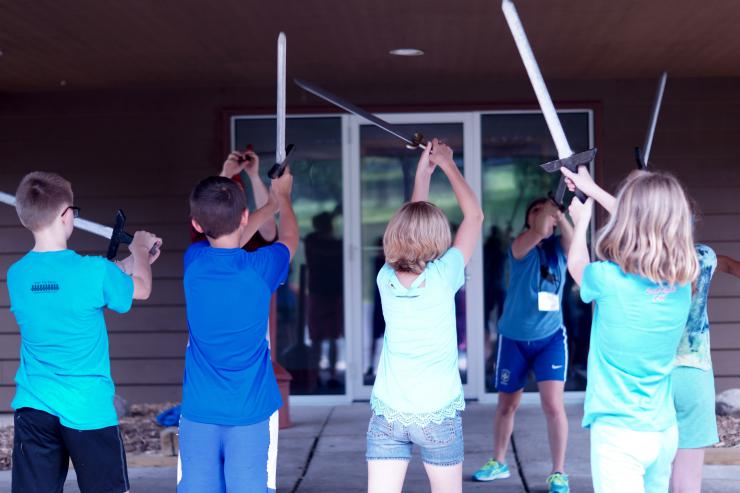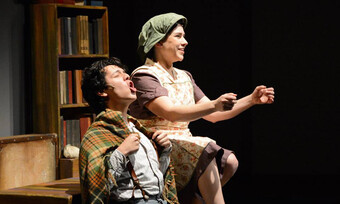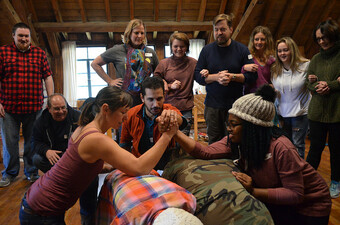When Young People Fight
Stage Combat in TYA
This essay is a reflection of my own practice as a fight instructor and choreographer for young audiences, as well as conversations with other members of the fight community in what I hope to be the start of a larger conversation with all researchers, practitioners, and educators interested in exploring youth and violence.
“Why are you teaching my child violence?”
This is one of the most frequent questions I get as a teaching artist who specializes in stage combat. We heard it so much at the theatre that I worked for that the education director decided to stop offering classes in stage combat all together.
The decision surprised me. From what I’d observed, the stage combat classes were some of our more popular classes, especially for students on the fence about acting. No one had ever gotten hurt in one of my classes, and everyone seemed to enjoy their newly acquired skills. How could we just stop offering classes? Why were parents so adamant to shut them down? Didn’t they realize it was all just pretend, that their kids were only having fun?
While some teachers have been excited to have me lead a stage combat workshop in their classroom, most schools have been uneasy or uninterested in the idea of intentionally bringing representations of violence into their schools.
As an instructor interested in investigating pedagogical “best practices,” a large part of my research lies in examining the impact of training young people in stage combat. During my lessons I watch as young actors begin to hone a sense of presence onstage, becoming more confident in their choices and more adept at interacting with scene partners. When done effectively, I believe stage combat provides students with tools they can use in real life as well. Based on my observations, students who study stage combat gain skills in:
- Action/reaction; using their bodies to tell a story physically
- Differentiating the world of the play from reality
- Effective partner-collaboration onstage and during the rehearsal process
- Empathy through eye contact and the active care of one’s partner; an important part of not only being a good performer, but a compassionate human being in general
- Self-advocacy—learning to be assertive with your needs as an actor, then extending this practice to the real world as well.
The misgivings adults have about stage combat being performed by youth aren’t unique to Saturday morning classes. While some teachers have been excited to have me lead a stage combat workshop in their classroom, most schools have been uneasy or uninterested in the idea of intentionally bringing representations of violence into their schools. Try searching “youth and stage combat,” even in specialized child drama collections, and very few articles of relevance pop up. While there are many books written about how to direct fights, or resources for professional adult actors, there are almost no training manuals designed specifically to teach youth stage combat. In the field of Theatre for Young Audiences (TYA), we strive to develop a rich, nuanced field of pedagogy, looking at all of the ways we can engage with young people specifically without being condescending or obtuse. We have books upon books of how to teach kids empathy, or put on makeup, or even use power tools. Why is there such a gap in how we teach stage fighting?
First, it is important to recognize the paradox that is youth’s relationship with violence in the media. Between video games, reality TV, Game of Thrones, and the latest super hero movie, violence is a key player in marketing entertainment to youth. It’s seen as sexy, as thrilling, as admirable. Yet at the same time, adults tend to frown on youth reenacting this violence in public settings. (I speak from personal experience as a student sent to the principal for playing out a fight scene on the playground I’d watched on Buffy...).
I attribute this attitude—and the reluctance to include stage combat in youth theatre programming—in part to our discomfort as a society of seeing children perform violence. Violence in film and theatre may sell, but there’s often backlash from audiences when the killer is a character or actor under the age of eighteen. We see this paradox of youth violence played out in movies like the young girl in Kick Ass, and Arya Stark in the Game of Thrones TV series on HBO. As a society, we tend to treat young people differently onscreen. I myself am guilty of this: even with my appreciation of stage fighting and my love of working with young people, it has always been difficult for me to suppress the discomfort I feel during The Hunger Games’ “cornucopia blood bath” scene, seeing the bodies of young people dead at another youth’s hands.
And yet, violence is a very real part of everyday life. School shootings, gang violence, and police brutality are daily concerns for most youth in America. After the murder of Tamir Rice, it is not difficult to understand why parents might have concerns about their children playing with realistic looking theatrical weapons. We live in an era that has taught us only too well that violence can happen anywhere. The same week I was preparing for skills proficiency tests for my stage combat certification, violence erupted in Dallas and my hometown of St. Paul. The emotions I felt rocked me to my core. How could I delight in picking up weapons when real violence was being used as a tool of oppression? How could I enjoy the awesome kill stroke I deliver to my partner, when in the real world, others weren’t getting up after an attack? As a fight community, we came together to reflect on the weekend, and the director spoke of how important it is to tell stories of violence; to help audiences process conflict and to bring awareness to real issues we face as a society.

Studying stage combat also allows its practitioners an opportunity to explore their own attitudes towards violence. For example, while rehearsing unarmed fight scenes in a class I was teaching, a student brought up the fact that she was uncomfortable watching a scene where a female character is hit by her male scene partner, saying she felt it was “illegal” for a man to hit a woman. Her classmate asked why she didn’t have the same reaction when the tables were turned, and a female character was the aggressor. This led to an intense yet thoughtful exploration of our own feelings on domestic abuse; a conversation I feel was made stronger by the fact that we were able to embody the violence onstage and explore both roles of the assailant and the person being attacked in a safe and removed way.
That isn’t to suggest that stage combat isn’t dangerous for young people, however. A fight director’s primary role in a production is to keep the actors safe during any moments of staged violence. This gets much more complicated when children are involved. Regardless of how safely a fight director may block a fight, accidents happen. With adult actors, we can accept this risk, and charge the actors with keeping themselves and others onstage safe. It’s harder to operate with the same understanding with youth. I know an experienced fight director who made the decision to stop blocking fights with young actors after having to take a ten-year old actor to the hospital with a broken bone when a stunt in Oliver! went wrong during a rehearsal. Our responsibility as fight directors to keep actors safe increases exponentially with young people who are less in control of their bodies, and less aware of their surroundings. You can ask an adult to accept that in participating, they are knowingly putting their bodies in potential danger; how can we ask young people to understand this in the same way? Children are resilient. Their bodies heal quickly, and they bounce back so much faster than adults. How can we ask them to accept the potential risks in the same way as adults?
And the concern of risk goes beyond youth’s physical well-being; their mental health should also be considered. Young actors need to be taught how to step out of role after a fight rehearsal, as well as developing an understanding that what helps them cope may not be the same as what their scene partner needs. Some fight instructors suggest that stage combat isn’t an appropriate area of training for young people. For example, in the blog “Play Fighting,” Dave McCormick states that he believes that stage combat should not be taught to any actors younger than sixteen years old. Partly, he explains, this is because they should be focusing on other more practical areas of honing their acting craft, but he also opposes teaching youth based on moral grounds. He writes,
...stage combat demands a mature mind in the moral sense... We want to play a death scene that is touching, a torture that is creepy, a murder that is dark, or a rape that is terrifying. ...The stage combat actor must imagine it. And it’s not right to subject kids to that.
I admit I have difficulties with McCormick’s arguments. It’s true that a young person’s emotional maturity has to be factored in when asking them to take on a role that includes fighting, either as the victim or the aggressor. But placing an arbitrary age limit on emotional maturity is disrespectful to the youth we serve, and speaks to the same frustrations we have in the field of TYA in general. McCormick’s concerns also create a bit of a straw-man argument. I believe I can say with certainty that no one is advocating for more six-year-olds performing in rape or torture scenes. But there’s a spectrum of violent situations, and a whole world of fight moves that can take place in a play without falling under the categories of rape or torture.
Because fights still exist in TYA. Whether it’s just a slap or a tussle with a bully, like in Oliver!, or a full out brawl, like in Peter Pan, violence finds its way onto the TYA stage for the same reasons as it does in theatre for adults: conflict. Conflict drives the narrative of a play; it’s what makes the story interesting, and makes us care about the characters. Plus, it’s just fun to watch. Look at Romeo and Juliet, commonly studied in schools: a love story that still has five dynamic fights to keep the audience entertained and invested in the narrative of literal life or death. All those beautiful words creating vibrant, evocative images, and yet there still comes a point when language fails his characters.
What I wish I could get parents and concerned adults to understand [is] in teaching stage combat, I am not teaching young people how to fight—these moves won’t help you in an actual physical altercation—I am teaching a young person how to tell a story with their body.
A few years ago, I had the honor of working on a production of Qui Nguyen’s hit play, She Kills Monsters. During the high school invitational performance, I sat in the audience surrounded by fourteen- to eighteen-year-olds, struck by how visceral the teens’ reactions were to the show. They gasped when the protagonist was struck by her boyfriend and went silent when two cheerleaders called another girl “dyke,” only to erupt with glee as the cheerleaders (now turned Succubi) were slayed mid dance-battle. For these students, it seemed the show had touched them in a very real way: Nguyen’s script captured both the reality of bullying and violence familiar to high school students, but also presented an escape into a super-hero fantasy where a young person actually had the power to do something about the forces that oppressed them. In this instance, stage combat played a huge role in reflecting a young person’s world back to them.
The Society of American Fight Directors defines stage combat as
...a broad term that covers acts of conflict, danger and/or violence performed for entertainment. More than just set moves, true stage combat uses violence to tell a story, just as dance choreography, set design, or costuming can.
And this is what I wish I could get parents and concerned adults to understand. In teaching stage combat, I am not teaching young people how to fight—these moves won’t help you in an actual physical altercation—I am teaching a young person how to tell a story with their body. A difficult story for an audience to watch, but a story all the same; one that perhaps in this day and age, we need to take a closer look at, not ignore. And if I’ve done my job effectively, I am teaching them also how to be present with their scene partner, and how to react appropriately and safely when something goes wrong onstage.








Comments
The article is just the start of the conversation—we want to know what you think about this subject, too! HowlRound is a space for knowledge-sharing, and we welcome spirited, thoughtful, and on-topic dialogue. Find our full comments policy here
Wow! I thoroughly enjoyed reading these well articulated thoughts! Thank you for this!
Love this. Thank you.